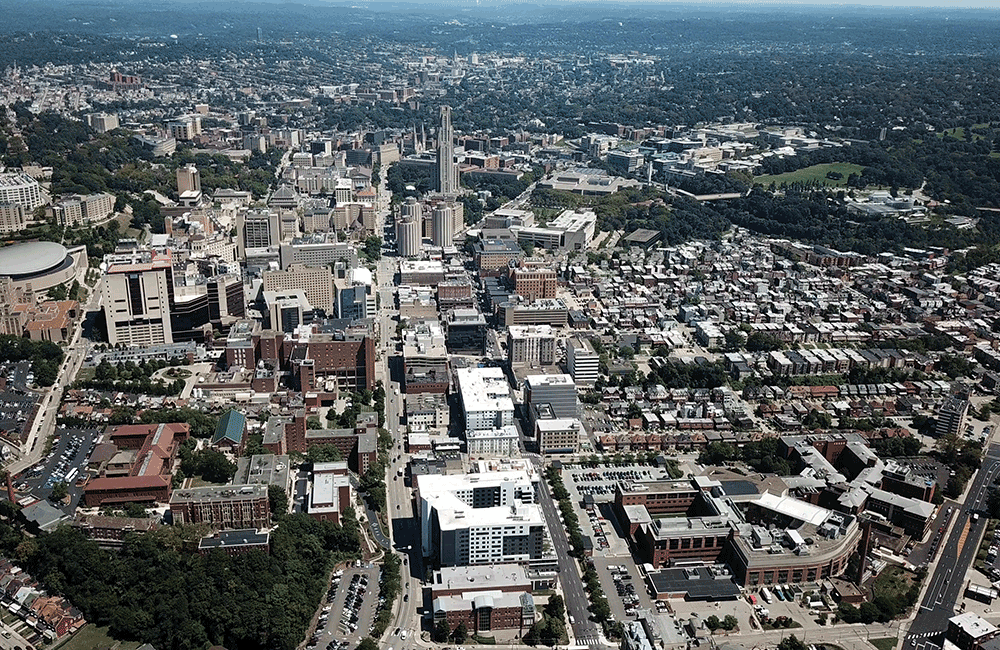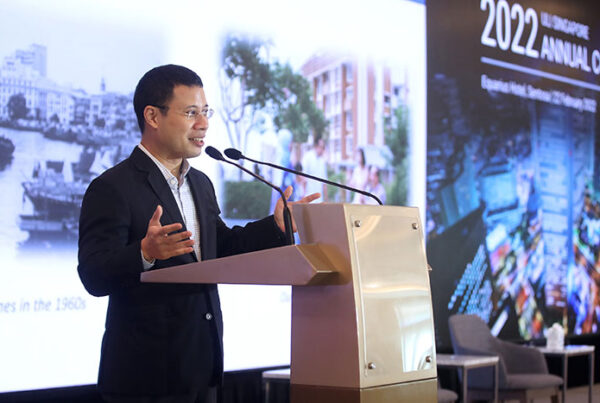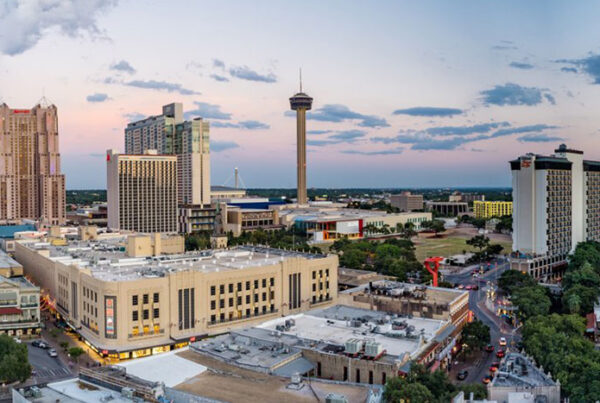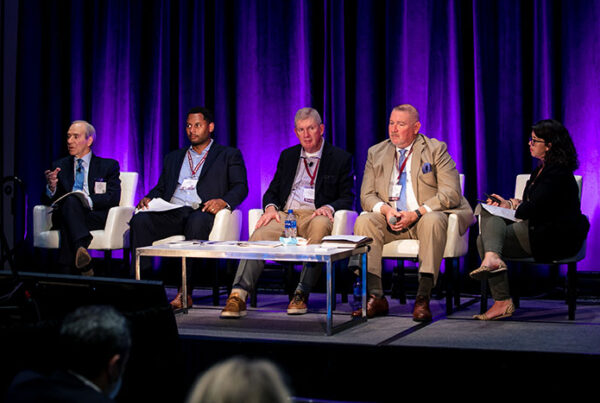
Pittsburgh’s Oakland neighborhood. (Mike Lee/Studious One)
The concept of the “15-minute city”—in which all human needs are within reach by walking or bicycling for 15 minutes or less—has gained momentum among urbanists, planners, designers, and policymakers. Brought to popularity by Paris Mayor Anne Hidalgo, who made it a cornerstone of her successful 2020 reelection campaign, the concept is being embraced by planners in cities from Singapore to Brooklyn to Portland, Oregon, all working toward visions of their own version.
The 15-minute city highlights human scale and decentralization as core themes in pursuit of a more transparent, reliable, and flexible transportation system. If people live within a short distance of food suppliers, health services, and employment, they are less affected if the bus is late, the subway floods, or a taxi is stuck in traffic.
Infrastructure is more than just bridges, electrical grids, and water lines. President Joe Biden, through his proposed American Jobs Plan, recently elevated this idea by putting broadband access, housing, and elder care on the same plane as roads. His framing of infrastructure as both physical and social assets and networks is both novel and obvious.
And it presents a critical moment for decision-makers to think beyond just transportation assets. As cities await federal infrastructure funding, their planners would do well to broaden their definition of what infrastructure means and what it can look like inside a 15-minute radius.
As the real estate industry commits to addressing the world’s greatest challenges regarding equity, climate change, and resilience, it must help broaden the discussion to include a range of enabling urban systems such as energy, water, food production, and material infrastructure—and this time design them both for and with the people these systems serve.
“De-infrastructured” Systems
 De-infrastructuring is a term I use to describe the breaking down of large-scale infrastructure systems, more closely connecting supply (sources and distribution) with demand, and creating community-scale investment in urban systems. The 15-minute city represents the de-infrastructuring of the transportation system. It connects people to goods and services in a carbon-free and—I would argue—more equitable way. People in a 15-minute city can understand the transportation system and in turn are more likely to participate in it, influence its design and operation, and advocate for its function and form.
De-infrastructuring is a term I use to describe the breaking down of large-scale infrastructure systems, more closely connecting supply (sources and distribution) with demand, and creating community-scale investment in urban systems. The 15-minute city represents the de-infrastructuring of the transportation system. It connects people to goods and services in a carbon-free and—I would argue—more equitable way. People in a 15-minute city can understand the transportation system and in turn are more likely to participate in it, influence its design and operation, and advocate for its function and form.
The 15-minute-city concept highlights walkable or bikeable access to grocery stores and restaurants but does not capture the interconnection with the larger food network—production, processing, transportation, and waste handling. As currently envisioned, the concept depends on the larger food system to function. A local alternative should strive to break down heavier, unsustainable, and risk-prone infrastructures—or at least complement them. To limit the climate impact of the food system and increase its resilience, we need to de-infrastructure it.
De-infrastructuring energy systems entails breaking down large-scale utility generation and bringing distributed power generation closer to the demand. Microgrids, district thermal energy systems, and integrated solar power de-infrastructure the grid and provide a wide range of community benefits.
De-infrastructured water systems would bring more rainwater capture and reuse and decentralized treatment options to the district, campus, building, and human scale. Of course, it is important to understand the economies and efficiencies of scale and be intentional about exploring de-infrastructured approaches during planning and policy discussion.
U.S. cities can draw on the work already done to define the transportation ecosystem of the 15-minute-city concept. This concept does not suggest that highways, heavy rail, and planes be eliminated; rather, to complement these larger networks with localized systems that increase access and provide local connections. The same should apply to all urban systems. A solar-powered microgrid works in concert with the utility grid; a university’s graywater system works in concert with a city-scale central wastewater treatment system.
The lack of transparency in urban infrastructures presents one of the greatest challenges for change—and therefore one of the greatest opportunities. Current infrastructures offer little opportunity to see how people affect the system. Energy generation, transmission, and distribution are either out of sight, too technically complex, or buried in pipes and wires. Few people really understand where drinking water comes from and where wastewater goes when it leaves our homes. Where does our garbage go?
Moreover, typically we only learn how fragile these systems really are through crisis. We assume the systems will work in good times and in bad. Although infrastructure systems appear strong and reliable, they are in fact fragile and full of weaknesses—as revealed recently by the power outages in Texas and the cargo ship stuck in the Suez Canal, snarling international trade. Infrastructure systems are becoming even more vulnerable as climate change turbocharges the intensity and frequency of infrastructure breakdowns.

Figure: Transition from Infrastructured to De-infrastructured 15-Minute City, with Benefits Highlighted . (Click to Zoom)

Figure: Infrastructured Food System

Figure: De-Infrastructured Food System
Co-Benefits and Equitable Systems for All
De-infrastructuring, if given the necessary time and consideration in planning and policy discussions, will unlock big, bold, and transformative ideas. It will create a basis for dialogue on how localizing systems and networks can more closely align with the needs of users. If systems are broken down to a scale at which people can understand and influence them more opportunities will emerge to shuffle the pieces, reconfiguring them and building them up in ways that provide maximum benefits.
It can also provide an opportunity for intentionality in addressing the historic, present, and potentially emerging inequities of a system. For instance, an energy system solution may present an opportunity for workforce development and local education programs not offered as clearly by current infrastructure systems.
For example, my consultancy convened a recent workshop with Walnut Capital, a Pittsburgh-based developer in the initial stages of building a framework for a large mixed-use development adjacent to a low-income and historically marginalized community. The team outlined the costs and benefits of creating a community resilience hub—co-locating an energy substation, community solar facilities, district cooling, and rainwater storage for reuse as cooling tower make-up water. Walnut Capital, which has a longstanding relationship with the community, was able to see how these de-infrastructured strategies could provide more resilient power, address energy burdens in the community, and offer opportunities for educational programs and workforce development for residents.
“It’s been increasingly clear to us that we need to really challenge the larger systems that serve our neighborhoods and look beyond the boundary of our individual developments,” says Todd Reidbord, founding partner and president of Walnut Capital. “Resilience to us is as much about building those neighborhood networks and human connections as it is about hardening our infrastructure.” He said the process helped his company challenge scale and see its role in creating more equitable developments.
My colleagues on the ULI Sustainable Development Council see a similar opportunity.
“Our industry’s concept of infrastructure is often limited to large scale and government supported programs that are critical but slow to adapt at a systems level,” says Julie Hiromoto, principal and director of integration at HKS. “Expanding our thinking to also include distributed yet integrated networks of agile and entrepreneurial components will provide timely and much-needed support while larger, more resilient systems are built. We are exploring how best to integrate decentralized but connected insertions of cross-functional modules into communities to increase equitable access to care.”
S. Bry Sarte, chief executive officer of Sherwood Design Engineers,sees a link between localized infrastructure and creation of more resilient and interesting communities.
“There is a common association between efficiency and need for centralized control with regard to infrastructure,” says Sarte. “[D]istributed systems with localized interventions can provide an effective complement to the citywide systems. Granularity and complexity make cities and urban habitats more interesting, more flexible, and more resilient. Layers of infrastructure can be developed to support layers of culture and other human systems. Investing more in durable community-focused amenities is more effective with locally scaled infrastructure investments.”
I also encourage Urban Land readers to visit the Urban Sustainability Directors Network resource on resilience hubs for best practices across North America.
There is also an economic argument for de-infrastructuring. Instead of a single owner or actor of a large system with a single point of control and regulation—which has its benefits—de-infrastructuring requires multiple actors, new partnerships, cooperatives, and funding mechanisms. De-infrastructured systems may require a larger capital outlay than that for simply connecting to a larger system, but an expanding set of models has emerged for shared investment, ownership, and operation that can offset or defer these upfront costs. The longer-term benefits include lower life-cycle costs, lower carbon emissions, increased reliability, risk avoidance, and community benefits that will prove financially attractive. To make the case, we must also weigh the benefits against the societal costs of staying the course.
Building Back Better
This is a critical moment as we “build back better”—to borrow a tag line from President Biden’s proposed infrastructure plan—as U.S. cities look to solve big challenges of climate change and racial equity. Although several barriers to fully de-infrastructuring cities exist, the importance of building resilient networks is more critical now than ever. Individuals, companies, institutions, community groups, and investors are asking the difficult questions about how our cities can work better for them and provide sustainable, equitable, and resilient outcomes for everyone. The answer is for our urban actors to apply a 15-minute-city mentality to all urban systems.
And no, the “Paris to Pittsburgh” ongoing metaphors were not lost on me. President Biden announced his infrastructure plan in my backyard, where I see the immediate need for reimagined urban systems working for everyone.
Through the COVID crisis, we have seen the ability of the world to pivot quickly—to change behaviors and challenge the scale of our lives and the systems we live in. I agree wholeheartedly: we can do this.
STEVEN BAUMGARTNER is founder and director of Pittsburgh-based Baumgartner Urban Systems Strategy (BUSS) and a member of the ULI Sustainable Development Council.




